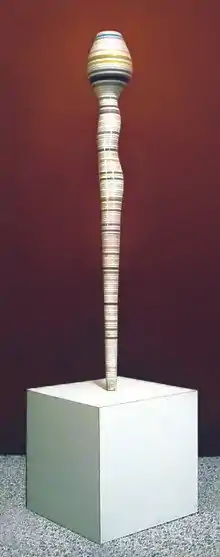Robert Mallary
Robert W. Mallary (Dec. 2, 1917 – Feb. 10, 1997) was an American abstract expressionist sculptor and widely acclaimed pioneer in computer art. In the 1950s and '60s, he was renowned for his Neo-Dada or "junk art" sculpture, created from found materials and urban detritus, held together with hardened liquid plastics and resins. Mallary created the first digitally modeled sculpture, Quad 1, which was displayed at the "Cybernetic Serendipity" exhibit in London in 1968.

Mallary was born in Toledo, Ohio, and grew up in Berkeley, California. He was interested in art from his youth, and went to Mexico City to study at the Escuela de Las Artes Del Libro (now the Escuela Nacional de Artes Gráficas) in 1938-39, and then at the Academy of San Carlos in 1942-43, where he was inspired by José Clemente Orozco and David Alfaro Siqueiros. He also studied at the Painter's Workshop School in Boston, Massachusetts in 1941.
While continuing to pursue his fine arts career, Mallary worked as an advertising Art Director in Los Angeles from 1945-48, and as a freelance commercial artist until 1954. His paintings (made with liquid polyester) were shown at the Urban Gallery in New York City in 1954, where he had four other exhibits until 1959. His work was also shown at Gump's Gallery in San Francisco (1953) and the Santa Fe Museum in Arizona (1958).
Mallary taught at the California School of Art in Los Angeles in 1949-50, at the Hollywood Art Center from 1950-54, and then became Professor of Art at the University of New Mexico in Albuquerque from 1955-59. When he moved to New York City in 1959 to teach at Pratt Institute in Brooklyn, Mallary became part of the New York art scene, along with such artists as Willem and Elaine de Kooning, and Wayne Thiebaud. (In the 1940s, Thiebaud and Mallary had been art directors at the Rexall Corporation in Los Angeles.) In 1967, Mallary became Professor of Design and Computer Graphics at the University of Massachusetts in Amherst, where he taught for nearly 30 years, until his retirement in 1996. Mallary also taught for brief periods at Pennsylvania State University (1962), University of Minnesota (1965), and the University of California at Davis (1963, 1967).
Mallary's abstract relief sculptures and assemblages, created from discarded cardboard, fabrics, sand and straw – and held together with hardened polyester resin – were featured in Life Magazine in 1964. Mallary had already been known for his technological innovations in art even before he became a computer artist in the late 1960s; his light sculptures had been featured in the pages of Time magazine in 1952.
Mallary's monumental "Cliffhangers" sculpture was exhibited outside the New York State Pavilion at the 1964 World's Fair in Flushing, NY. His work was featured in the "Sculpture U.S.A." and "Sixteen Americans" exhibits at the Museum of Modern Art in New York City in 1959, and then at its "Art of Assemblage" exhibition in 1961. Mallary was awarded a Guggenheim Fellowship in 1964.
The Allan Stone Gallery in New York City had four exhibits of Robert Mallary's work between 1961-66. Mallary's sculpture, Pythia was purchased for The Governor Nelson A. Rockefeller Empire State Plaza Art Collection in Albany, NY in 1966. The State University of New York in Potsdam had a Robert Mallary Retrospective exhibit in 1968.
Mallary's first computer-generated sculpture, Quad 1, was displayed at the "Cybernetic Serendipity" exhibition at the Institute of Contemporary Arts in London in 1968. Both Quad 2 and Quad 3 were constructed by stacking layers of shapes cut out of plywood — shapes which were drawn by a computer sculpture design program, TRAN2 (written by Bob's son, Michael Mallary, under his direction) — before the sections were assembled into a final, laminated piece.
In 1993, Mallary had a show at the Mitchell Algus Gallery in New York City. His sculptures, assemblages, computer graphics, and stereoscopic 3D projection art were exhibited at the Herter Gallery at UMass in 1990, and at the Springfield Museum of Fine Art in Massachusetts in 1995. The Mayor Gallery in London presented the exhibition, "Robert Mallary: The New Mexico Reliefs 1957-58" at Frieze New York in May, 2017. In 2018, The Mayor Gallery displayed Mallary's computer-generated sculpture, Quad 3 , along with his computer drawings in the exhibition, "Writing New Codes: 3 Pioneers in Computer Art 1969-1977." The Mayor Gallery sold Quad 3 to the Tate Gallery in 2019.
Mallary had liver problems in later life, probably due to the toxicity of the liquid polyesters he had used to create his abstract expressionist sculptures in the 1950s and '60s. He lived in Conway, Massachusetts, and died of complications due to leukemia at Cooley Dickinson Hospital in Northampton, Massachusetts in 1997, at age 79. He is survived by four children (Michelle, Michael, Martine and Martin), and four grandchildren.
References
- Obituary, New York Times, 15 February 1997
- Robert Mallary, compArt Digital Art database
- Robert Mallary, The Mayor Gallery
- Robert Mallary, Museum of Modern Art, New York
- Robert Mallary, Getty Union List of Artist Names
- Robert Mallary, The Box, Los Angeles
- Biography, robertmallary.com
- Robert Mallary: Pioneer Computer Graphic Artist, robertmallary.com